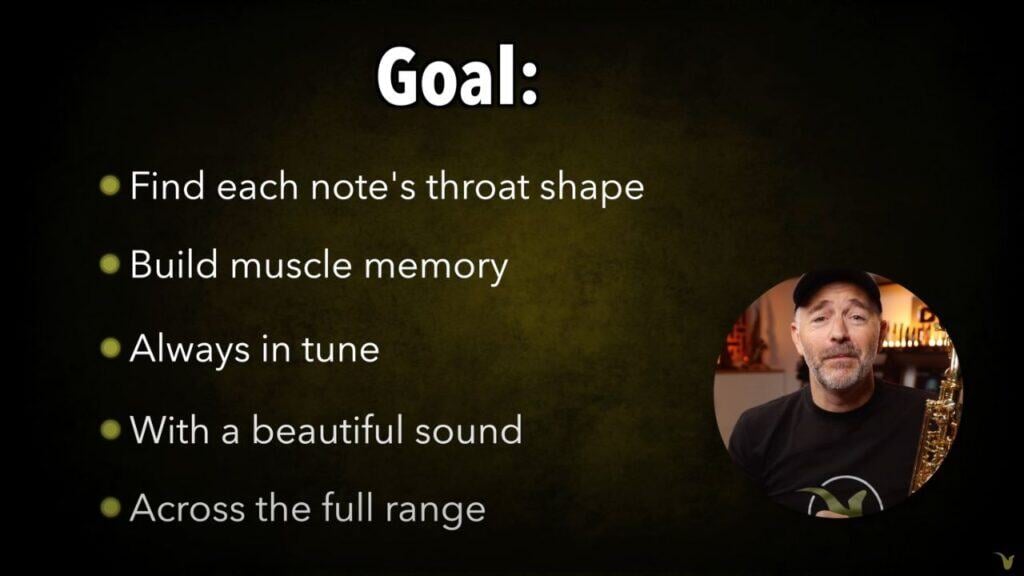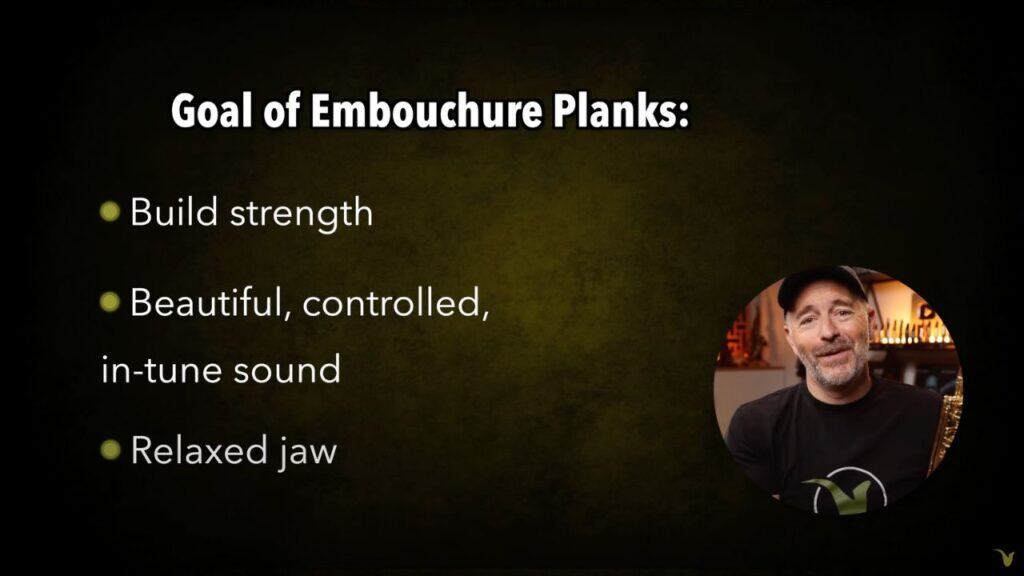
Gorgeous Sax Tone in 5 Minutes a Day
- By Jay Metcalf
- Saxophone Fundamentals, Saxophone-Lessons

Check out the audio podcast version of this post on Apple Podcasts or Spotify.
Want a beautiful saxophone sound, but don’t want to spend an hour a day on long tones? After years of practicing and teaching, I found a warm-up that delivers even better results in just five minutes a day. So, in this post, I’ll show you how to practice this warm-up so you can develop a gorgeous tone quickly. If your sound isn’t good, nobody wants to listen, no matter what you play. But here’s the problem. You’ve got scales, exercises, and tunes to learn at the same time. So, how do you fix your sound without falling behind? That’s where this 5-minute warm-up comes in. It’s designed to improve your sound and five other key skills all at once so you get more bang for your buck. Here’s how it works.
Skill 1 – Intonation

While we’re developing that beautiful saxophone tone, we’re also going to learn how to play every note in tune every time. Everybody tells you to use a tuner for this, but that only helps you tune when you’re looking at it. We can’t rely on our eyes to play in tune. We have to use our ears. So, for this warm-up, we’re going to be using drone tones as our reference point for intonation. My favorite app to use for this is Tonal Energy with earbuds in and the microphone turned on. Let’s start with your saxophone’s middle C, which is an easy note to play in tune with a relaxed and neutral embouchure. Start the drone and play along.
Use breath attacks. No tonguing here. Just try to match your pitch with the drone. When you’re out of tune, you’ll hear the frequencies out of sync. There’s going to be a noticeable pulse that gets faster the more out of tune you are.
Find the pitch center and lock in. Now you’re developing your sound and intonation at the same time. Move to the next note a half step down and repeat.
Skill 2 – Embouchure Strength

Now, you may already feel a little tired here, and you’ll notice that makes it harder to maintain a steady tone that’s in tune. Our five-minute warm-up is also going to help us build strength and endurance. That’s why I call these Embouchure Planks.
Just like working out in the gym, you have to keep good form to get maximum benefits. It’s okay to take breaks as you’re building your muscles. Doing this 5-minute embouchure planking warm-up every day for a month will completely transform your sound. That’s only two and a half hours of total practice time. But if you did it all in one session, it wouldn’t work. Just like any other muscles in our body, we need to work them, then allow rest time so they build back stronger. Our goal is to build the strength necessary to play with a beautiful, controlled, in-tune sound with a relaxed jaw for a long time. There will be a natural tendency to bite as you get tired. Using softer reeds can really help here.
Now, let’s make this even more effective. Set your metronome to 64 beats per minute. There are 33 notes on your saxophone. So if you play each note for eight beats and take a breath for one beat, you can do the entire range in under five minutes at that tempo.
Don’t worry if you can’t make it through in one go at first. Take breaks and give yourself time to build up your strength. Stick with this warm-up daily and you’ll soon be playing more in tune for longer with a more beautiful tone. Let’s do a few more planks using this formula.
Embouchure strength is only half the battle though. If you want a golden saxophone tone, you need more than just strength. You need precision. That’s where muscle memory comes in.
Skill 3 – Muscle Memory

As you do your embouchure planks, you’ll notice that each note has its own unique throat position that produces a warm in-tune sound.
Your goal is to find that shape for each note and build muscle memory so you always play in tune and with a beautiful sound across the whole range. The lowest and highest notes on your saxophone are going to have the most different throat shapes, though, which is why we start our planks in the middle of the horn where the shape is the most neutral. As we go down chromatically, we’re making micro adjustments for each note. Your instrument, mouthpiece, reed, and even personal anatomy makes this process truly unique for each individual.
You have to experiment and find what works for you in your setup. There’s no other way. As we get lower on the saxophone, the frequencies are lower and we need to be very open and relaxed. Let that reed vibrate freely.
By now, I’m sure you realize how effective just 5 minutes of embouchure planking can be for your sound. But wait, there’s more. You can also use this sound warm-up to get incredibly relaxed finger and hand position, allowing you to play faster and more accurately.
Skill 4 – Good Finger and Hand Position

As we get into the lower notes, it’s really common to clamp down with a death grip on the keys. This is a habit you want to break early on. It can cause pain and even lead to injury down the line. During our warm-up, focus on using only the minimum pressure you need to keep the keys closed. If you’re pressing harder than that, ease up. Fingers that aren’t pressing a key should just rest lightly on the key touches. No squeezing or tensing up. Keep your hands relaxed with your fingers slightly rounded and your wrists straight.
Embouchure planks are perfect for this because they give you the time to really pay attention to what your fingers are doing. The more relaxed your hands are, the easier and faster you’ll be able to play, and you’ll avoid those aches and pains that come from tension. Once we get down to low B flat, move back to middle C to recalibrate to that neutral throat position.
Now, we’re going to work our way up chromatically.
As the notes get higher, we’re going to have even more of a tendency to want to bite. As you do your embouchure planks, focus on keeping good form. Some notes on your instrument are going to trend a bit sharper than others. Opening up your throat shape can help bring that pitch back down. Find the position where it’s in tune and lock that shape into your muscle memory.
Skill 5 – How to Use Your Air Correctly
Now, even if you develop that muscle memory, embouchure strength, and good hand position, there’s one more element that can sabotage your sound. I’ve seen so many saxophone players who never learned how to use their air correctly and efficiently. But with our embouchure planking warm-up, we can fix that, too.
Most saxophone students only ever take half breaths and leave a lot of unused air in the tank, which makes it very hard to play with your best sound. I want you to try and empty your air tank on each note and then fill it up completely with each inhalation. Having a full tank of fresh oxygen-rich air to work with is critical for a beautiful saxophone sound.
Keep in mind as we go up on the saxophone, the length of our tube shortens and we don’t need as much air as we did in the low range. You still want to support with strong air pressure, but you don’t need the same volume of air. That’s why you can play the higher notes for much longer with the same amount of air. Avoid the natural tendency to overblow and tense up on the high notes.
I challenge you to spend 5 minutes a day embouchure planking the way I showed you. Then come back and tell me the effect it’s had on your sound, endurance, intonation, and even hand position.
Now, here’s the best part about starting your practice session with this. You can then carry it over to everything else you practice and perform, like the great pentatonic scale workout in this article you should read next. Go practice these after doing your planks.
More Posts
Jay Metcalf
Leave a Comment
Your email address will not be published. Required fields are marked *
COURSES FOR
EVERY LEVEL
filter by difficulty using the tabs
- All
- Advanced
- Beginner
- Bundle
- Free
- Intermediate
- All
- Advanced
- Beginner
- Bundle
- Free
- Intermediate






One Comment
Jay, I enjoy listening to your demonstrations; you provide excellent information with coaching tips and advice to stay away from bad habits. Additionally, the words, phrases and manner you use to deliver the message are so convincing and encouraging, they make you the ideal teacher and Better Sax representative. Way to go!
Thanks, so much!